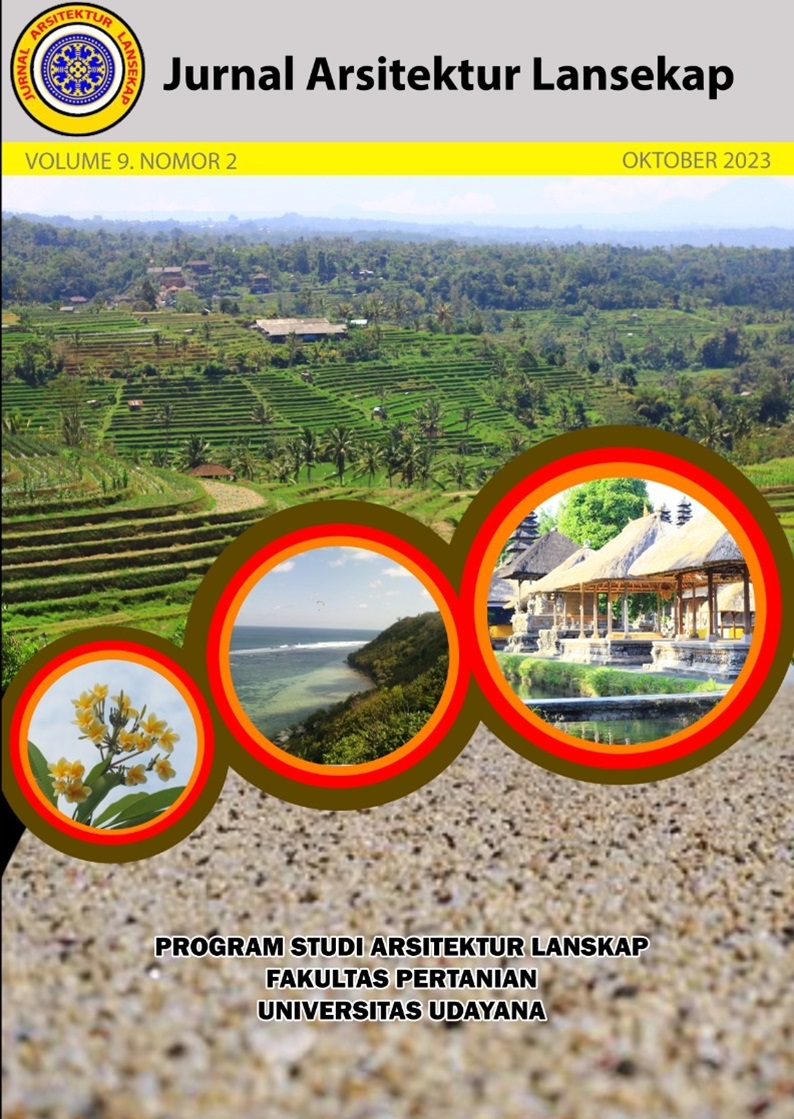Analisis Pengaruh Soundscape terhadap Kenyamanan Pengunjung di Taman Kota Sewaka Dharma, Denpasar, Bali
Abstract
Analysis of the Effect of Soundscape on Visitor’s Comfort in Sewaka Dharma City Park, Denpasar, Bali. Sound is non-physical element that get less attention in creating sense of place. Very difficult to find good soundscape quality in urban landscape because of the negative impacts of noise. The existence of Sewaka Dharma City Park as public green open space should be a solution of these problems. This study aims to identify sound, analyze effect of soundscape on visitor’s comfort, and provide recommendation to improve the soundscape quality. The study method used is survey, with data collection technics used were observation, questionnaires, and literature study. The data analyzed by quantitative and descriptive analysis. Soundscape of this city park created by combination of natural sounds, human sounds, sounds and society, mechanical sound, and sound as indicator. The most dominant sound heard is the sound of vehicles. Measurement of SPL (Sound Preassure Level) reached 67.5 dB and it exceed the regulation for green open space. Sound assessment indicated natural sounds and sounds from worship place were considered as quite comfortable. Most of human sound and society are considered as not disturbing. Sounds that quite disturbing are people screaming, vehicles and horns. Noise control recommended in zone I and J, because it result the highest SPL and considered disturbing visitor’s activities, by adding barriers and filters with plants, pavement and water.
Downloads
References
BSN (Badan Standardisasi Nasional). 2017. SNI 8427:2017 Pengukuran Tingkat Kebisingan Lingkungan. Badan Standardisasi Nasional. Jakarta.
Cerwen, G. 2017. Sound in Landscape Architecture. Doctoral Thesis. Faculty of Landscape Architecture, Horticulture and Crop Production Science. Swedia.
Departemen Pekerjaan Umum. 2005. Mitigasi Dampak Kebisingan Akibat Lalu Lintas Jalan.
Hagerhall, C., R. Taylor, G. Cerwén, G. Watts, M. V. D. Bosch, D. Press and S. Minta. 2018. Oxford Textbook of Nature and Public Health. Oxford University Press. Oxford.
Kementrian Lingkungan Hidup, 1996, Kep48/MENLH/11/1996 tentang Baku Tingkat Kebisingan, Menteri Negara Lingkungan Hidup. Jakarta.
Permatasari, S. A., I. G. A. O. Mahagangga. 2018. Studi Komparasi Taman Kota Lumintang dan Taman Kota Puputan Margarana Niti Mandala Renon sebagai Sarana Leisure and Recreation. Jurnal Destinasi Pariwisata. 6(2): 237-244. https://doi.org/10.24843/JDEPAR.2018.v06.i02.p06
Pradana, A., I. M. Tamba, I. K. Widnyana, W. Maba. 2019. Analysis of Traffic Noise in Taman Kota Lumintang Denpasar. International Journal of Contemporary Research and Review. 10(2):20585-20591. https://doi.org/10.15520/ijcrr.v10i02.652
Schafer, R. M. 1977. The Soundscape: Our Sonic Environment and the Tuning of The World. Clark & Cruickshank. Canada.
WHO (World Health Organization). 1999. Guidelines for Community Noise. World Health Organization. Geneva.
Yulianto, A. R. 2013. Faktor-Faktor yang Berhubungan dengan Gangguan Nonauditory Akibat Kebisingan pada Musisi Rock. Jurnal Kesehatan Masyarakat. 2(1): 1-11.

This work is licensed under a Creative Commons Attribution-ShareAlike 4.0 International License.
An author who publishes in the Jurnal Arsitektur Lansekap (JAL) agrees to the following terms:
- Author retains the copyright and grants the journal the right of first publication of the work simultaneously licensed under the Creative Commons Attribution-ShareAlike 4.0 License that allows others to share the work with an acknowledgement of the work's authorship and initial publication in this journal
- Author is able to enter into separate, additional contractual arrangements for the non-exclusive distribution of the journal's published version of the work (e.g., post it to an institutional repository or publish it in a book) with the acknowledgement of its initial publication in this journal.
- Author is permitted and encouraged to post his/her work online (e.g., in institutional repositories or on their website) prior to and during the submission process, as it can lead to productive exchanges, as well as earlier and greater citation of the published work (See The Effect of Open Access).
Read more about the Creative Commons Attribution-ShareAlike 4.0 Licence here: https://creativecommons.org/licenses/by-sa/4.0/.







